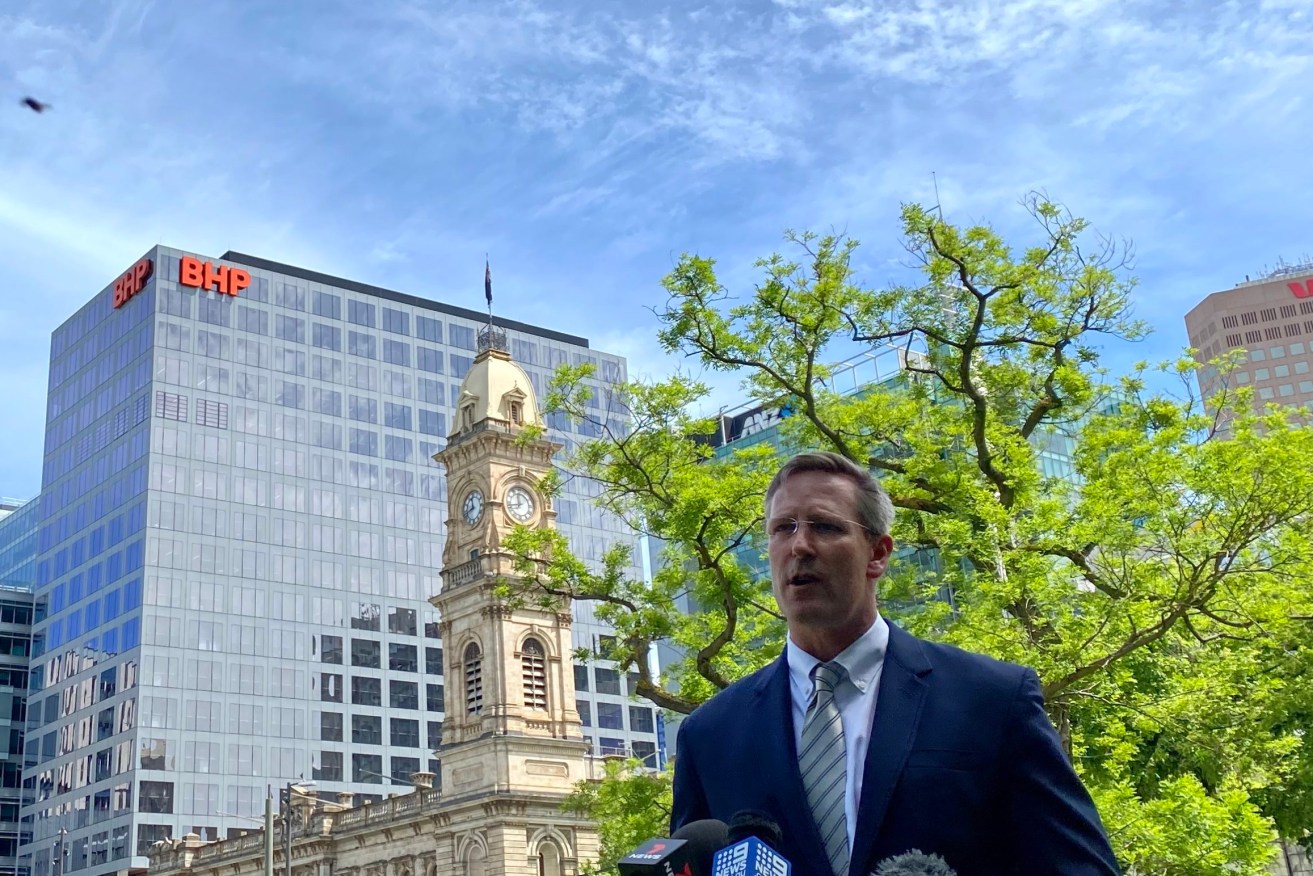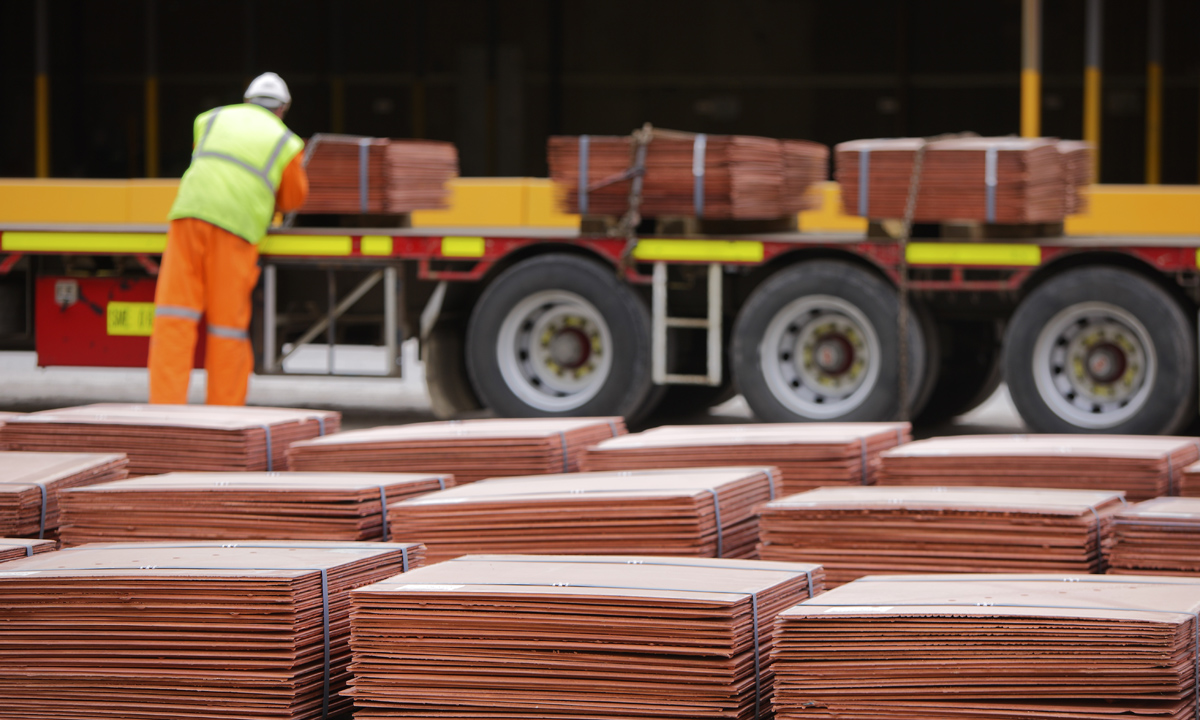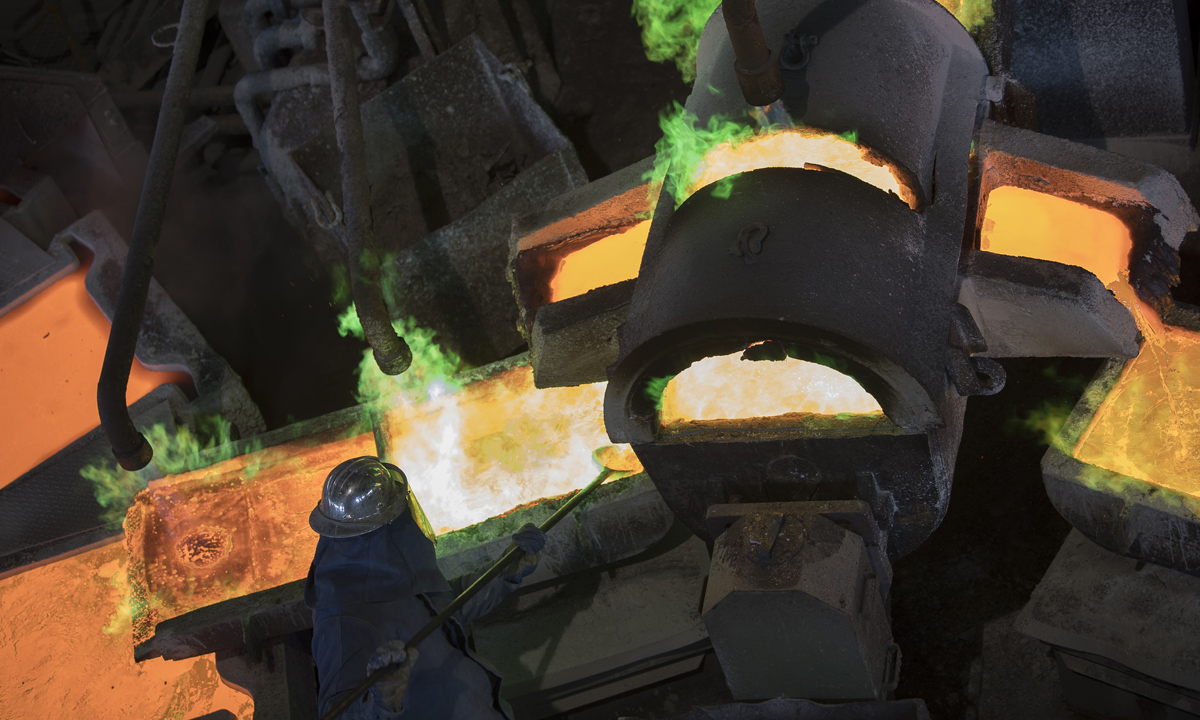BHP scraps major Olympic Dam expansion
BHP has scrapped its proposed $3.7 billion Brownfields Expansion at Olympic Dam in favour of a number of smaller projects to improve reliability and increase capacity.


Mining Minister Dan van Holst Pellekaan fronts media today, in the shadow of BHP's city headquarters. Photo: Tom Richardson / InDaily
The South Australian Government declared the Brownfield Expansion a major project in February 2019 after BHP announced it was investigating the ramp-up in 2017.
The project planned to increase copper output at Olympic Dam from 200,000 tonnes a year to up to 300,000 tonnes, supporting 1800 jobs in construction and 600 ongoing positions. It was also set to boost the level of gold, silver and uranium production.
However, the results of a study into the expansion, released to shareholders this morning, found that the copper resources in the Southern Mine Area were more structurally complex, and the higher-grade zones less continuous, than previously thought.
It was unfortunate timing for the Marshall Government, which was today trying to spruik its new Mining and Energy strategy, with Minister Dan van Holst Pellekaan insisting it remained “a terrific day for our energy and mining industries”.
“BHP are not going to do their expansion in the timeframe we’d have liked – that’s disappointing,” he conceded.
“We’d have liked them to do that sooner rather than later, but it’s the largest mine in operation in our state – it’s going to grow… BHP have committed to another $1.5 billion in expenditure and it’s a very important contributor to our economy.
“It will continue to grow, but it’s disappointing that the expansion on top of the current growth is going to be a little way down the track now.”
He insisted the eventual expansion “will happen” in some form, saying: “The resources are there – BHP have committed themselves, we’ve committed ourself.”
“The approach they’ve wanted to take isn’t viable, so they’ve now looking at another option.”
Van Holst Pellekaan said the Government “received confirmation in writing late last week” about BHP’s decision, which was reported to the market this morning, just hours after the Government spruiked its own vision, which includes increasing mineral export revenue and exploration spending as well as achieving 100 per cent net renewable energy generation by 2030 – an ambition the minister says “we’re very confident will deliver 25-30,000 jobs over the next ten years”.
He noted the timing was “disappointing” but “this day was the day they were required to release their quarterly market report [and] those dates just happened to coincide”.
BHP shelved a previous $30 billion expansion at Olympic Dam in 2012, citing falling commodity prices and slow global economic growth.
The company will instead focus on “targeted debottlenecking investments”, plant upgrades and modernisation of infrastructure to increase efficiency and production.
BHP acting asset president Olympic Dam Justin Bauer said the focus remained on completing an asset integrity program to support safe and stable operations at Olympic Dam.
“With our enhanced understanding of the underground resources at Olympic Dam, promising early results from Oak Dam and our focus on reliable operations, we have a positive outlook for Olympic Dam and the long-term opportunity for this asset,” he said.
BHP’s other Olympic Dam investments include a $500 million smelter maintenance and upgrade project to improve reliability and increase the capacity of its Olympic Dam copper smelter in the second half of next year.
The company says the project will require a peak workforce of up to 1500 people – in addition to Olympic Dam’s regular workforce of approximately 4000 – to upgrade the smelter’s furnaces and supporting infrastructure.

Bundles of copper being loaded for transport at Olympic Dam.
Major smelter maintenance is conducted roughly every four to six years and will include a planned shutdown of two to three months.
To support the smelter maintenance campaign, BHP will install approximately 700 temporary accommodation rooms. The balance of the smelter maintenance workforce will be accommodated in existing facilities.
Installation of the temporary accommodation will support a peak workforce of 125 people.
BHP has also refined the scope of assessments to a potential maximum Olympic Dam production of 300,000 tonnes of copper per annum, down from 350,000 tonnes previously being considered.
The reduction follows the outcome of initial assessments, and will in turn lower potential future water requirements from the Great Artesian Basin.
The announcements were part of BHP’s first-quarter operational Review for FY21 this morning, which showed Olympic Dam achieved its highest quarter of copper production since 2015.
The 52 kilotons produced was 8 per cent up on the June quarter figure and a 47 per cent increase on last year’s September quarter. However, its FY21 guidance of 180-205ktpa remains unchanged.
The company also reported promising results from the third phase of drilling at Oak Dam.
It follows encouraging results from the previous drilling phases, which confirmed high-grade mineralised intercepts of copper, with associated gold, uranium and silver.
Preparations are underway for the next phase in the first half of next year as the project 65km southeast shapes as potentially filling the void left by the Brownfield Expansion.
BHP has also committed to the physical replacement and commissioning of the refinery crane in the March 2021 quarter.
Meanwhile, the company says an upgrade of the Olympic Dam airport is progressing well and is on schedule for completion in the first half of next year.
The upgrade involves the construction of a new runway and new terminal facilities.
The new runway will support jet-engine aircraft with up to 100-person capacity, up from the current 50-person capacity.
The airport upgrade will support 130 jobs at its peak and is expected to be completed before the start of the smelter project.
In the 2020 financial year, BHP paid approximately $110 million to the South Australia Government, including about $77 million in royalties.

Molten copper being poured into casts at the Olympic Dam smelter.
Also released today, the government’s Building on our Strengths – South Australia’s Energy and Mining Strategy includes $5.6 million to help provide key mining infrastructure to the state’s north such as water and affordable electricity.
South Australia’s energy and mining sector contributed about $8.7 billion or about 8 per cent of the state’s annual Gross State Product (GSP) in 2018 and about 44 per cent of goods exports, valued about $5.3 billion.
Minister for Energy and Mining Dan van Holst Pellekaan said the strategy was expected to deliver 25,000 – 30,000 additional jobs by 2030.
“Ensuring our natural resources are developed and managed responsibly is an important element in ensuring South Australia eventually emerges stronger from the COVID-19 pandemic and the global economic downturn it has triggered,” he said.
Shadow Minister for Mining Tom Koutsantonis is already counting the 2400 proposed Brownfield Expansion positions as “lost jobs” despite the project still being in the study phase.
“This is a shocking blow to the South Australian economy when we can least afford it,” he said.
Globally, BHP Group Ltd posted a 7.2 per cent rise in first-quarter iron ore production, supported by stable demand from China, the world’s top consumer of the steelmaking ingredient.
Major miners have pinned their recovery hopes on an economic rebound by China, backed by Beijing’s commodity-intensive stimulus measures, as the world still grapples with the fallout of the COVID-19 pandemic.
The world’s largest listed miner said it produced 74 million tonnes of Western Australia Iron Ore in the three months ended September 30, up from 69 million tonnes a year earlier and slightly above a UBS estimate of 73.5 million tonnes.
Group copper equivalent production increased by 2 per cent in the September 2020 quarter.
“BHP has started the new financial year with a strong first quarter of safety and production performance. Group production rose two per cent from a year ago driven by solid results in metallurgical coal and iron ore, our major growth projects made good progress, and we secured more options in copper, nickel and oil,” BHP Chief Executive Officer said in a statement to the ASX.
“While our copper operations in South America continue to be impacted by COVID-19 preventative measures, we achieved strong concentrator throughput at Escondida and expect first production from the Spence Growth Option before the end of March 2021.
“In Australia, Olympic Dam delivered its best quarterly production in the past five years and we are on track for first production from South Flank in the middle of the 2021 calendar year.”
BHP shares were down 0.6 per cent in early trade to $36.26.
-Additional reporting by Tom Richardson




